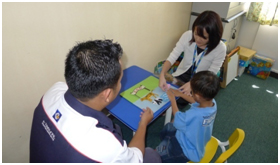Introduction
A speech-language therapist is a professional trained in the management of patients with speech, language, and swallowing difficulties. At the moment, speech-language therapists in Malaysia serve in government hospitals, private hospitals, early intervention centers, and related non-government organizations (NGOs).
 |
| Source: hus.moh.gov.my |
Services provided consist of the assessment, diagnosis, consultation, and treatment of disorders of:
Communication
-
Deafness / Hearing Impairment – therapy involves improving listening, speech and language skills with the use of hearing aid devices or cochlear implant. In some patients, augmentative and alternative communication may be used.Adult communication disorder –adult patients with communication difficulties, commonly caused by stroke or brain injury. Therapy involves introducing communication strategies and application of augmentative and alternative communication methods, for example picture communication system or gestural communication.
-
Pragmatic Language Disorder – difficulties in the use of language for communication and socializing, mainly faced by patients with Autism Spectrum Disorder or stroke. Therapy involves the introduction of effective communication strategies and application of augmentative and alternative communication methods.
Language
-
Pediatric Speech-Language Delay – delay in the acquisition of speech and language skills. Therapy includes promoting the development of language understanding and production.
-
Acquired Language Disorder – difficulties in understanding and using language which is often caused by stroke or brain injury. Therapy involves rehabilitation of language understanding and use.
 |
| Source: bharian.com.my |
Speech
-
Speech sounds disorder – difficulties in articulation or pronunciation. Therapy involves exercises promoting accurate ways of producing speech sounds.
-
Voice disorder – voice changes such as hoarseness, harshness, breathiness or loss of voice. Therapy includes improving voice qualities through exercises, training on correct voice usage and good vocal hygiene.
-
Fluency disorder – mainly stuttering. Therapy involves strategies to reduce the stutter and exercises to improve the way of speaking.
-
Resonance disorder – hypernasality, hyponasality or nasal emission most commonly caused by cleft lip/palate or neurological disorders. Therapy involves exercise to improve speech production..
-
Apraxia – difficulty in planning and coordinating the movements needed to make speech sounds. Therapy involves tasks to improve speech coordination and the use of augmentative and alternative communication if necessary.
-
Dysarthria – difficulty in speaking caused by reduced strength in the muscles involved in speech production. Therapy involves exercises to improve muscle strength and the use of augmentative and alternative communication if necessary.
Swallowing
-
Adult swallowing disorder (dysphagia) – difficulty chewing and/or swallowing often caused by stroke, neurological deficits or head and neck cancer. Management includes assessment and diagnosis of the problem either subjectively or objectively (with flexible endoscope or diagnostic imaging) as well as consultation regarding modification of diet and exercises to improve swallowing skills.
-
Pediatric feeding disorder – difficulty in chewing and/or swallowing often caused by genetic disorders (for example Down’s syndrome, cleft lif/palate, cerebral palsy, etc.) or swallowing incoordination. Management includes assessment and diagnosis of the problem either subjectively or objectively ( with diagnostic imaging) . Consultation regarding positioning, methods of feeding, and exercises to improve feeding skills are also provided.
Conclusion
Speech-language therapists often work together with other professionals such as doctors, audiologists, occupational therapists, physiotherapists, dietitians, nurses, and teachers,. to ensure that the best and most comprehensive treatments are given to the patients at all times.
Parents, family members, and caregivers of patients attending speech-language therapy play an important role in helping and supporting the patients. They will learn strategies such as how to stimulate language, train speech, and improve swallowing muscles or functions, in the sessions so that carry over can be done at home to ensure that intervention or treatment is effective.
| Last Review | : | 28 August 2020 |
| Writer | : | Siti Suhana bt. Mohd Khalid |
| Accreditor | : | Yong Ennie |
| Reviewer | : | Nadwah bt. Onwi |







